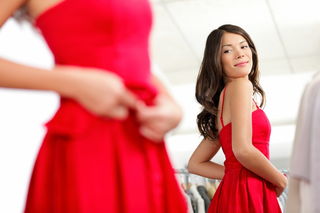
Source: Ariwasabi/Shutterstock
Research has shown that wearing red clothes can make women more attractive to men. But do women take advantage of this fact by wearing red when they want to attract a man’s attention?
The color red is strongly linked to desire and attraction. Men are more attracted to women who wear red (1,2), and it seems that women who want to attract men do so by wearing red. For example, there is evidence that women report wearing red clothes more often during the fertile phase of their menstrual cycle (3). Women responding to an online survey also reported that they would be more likely to don a red outfit when dressing for a date rather than a non-romantic encounter (4).
However, scientists are never satisfied until they tackle a question from every angle. How do we know for sure that women prefer to wear red when they go on dates? Can we trust respondents to an Internet survey? They may think that they would dress in red for a romantic encounter, but the reality could be much different. (Very few of us keep a precise diary of which clothes we wear to every social occasion.) Also, even in laboratory studies in which women express a preference for one clothing color over another, the choice given is usually between fire-engine red and some other equally garish shade.
Is this guy for real?
Daniela Niesta Kayser of the University of Potsdam in Germany, along with collaborators in Munich and the U.S., invited women to visit the lab to participate in a psychology experiment (5). Interested women received email directions to the lab, along with a photograph of a male undergraduate researcher who would be running the experiment.
The team included the photograph in the email so that the women would be able to recognize the researcher when they arrived—at least, that’s what they told the women. In fact, the “researcher” was one of two students from another university whose photographs 20 women had previously rated for attractiveness. One man received an average score of 6.6 out of 9; the other got a score of 3.9 (not so hot).
Half of Niesta Kayser’s volunteers received a photo of the more handsome man, and the other half received a photo of the less attractive student. When the volunteers showed up at the lab, they learned that the researcher they were supposed to meet was unavailable, and so another researcher would be running the experiment. That researcher took a full-body photo of the volunteer.
Later, other research assistants, who had no idea what the study was about, pored over the photos and made a note of what each volunteer was wearing. They classified volunteers as wearing red if any part of their clothing, including accessories, was red, pink, or scarlet. Colors less similar to red (e.g., orange, maroon, purple) did not qualify.
Results
Women were more likely to show up to the lab wearing red if they expected to be greeted by the handsome man: 57% of the women who expected to meet the attractive man wore red, but only 16% of the women wore red when they expected to meet the unattractive man.
But were women choosing to wear red to attract the more attractive man, or choosing to wear less red to put off the less attractive man?
Niesta Kayser checked how many women in the same university normally wore red by observing 200 customers at a campus cafeteria: 32% of these women wore red, roughly halfway between the percentage who had worn red to meet the researcher who was attractive hot and the percentage who had worn red to meet the researcher who was not. Assuming that cafeteria customers represented a baseline population, this suggested that volunteers in the main study were choosing to wear more red to meet the attractive researcher, and choosing not to wear red to meet the unattractive researcher.
As the authors of the study wrote:
Women often enhance their attractiveness as a way of competing with other women to gain the attention of desirable men. This phenomenon may extend to color displays, as the color red appears to be one feature that enhances perceptions of a woman’s attractiveness.
They also suggest that future research could test the effects of female-female competitiveness on women’s desire to wear red clothing.
For an audio version of this story, see the 5 April 2016 episode of The Psychology of Attractiveness Podcast.
Support Rob at patreon.com/psychology and receive bonus podcasts and blogs.
![]()






